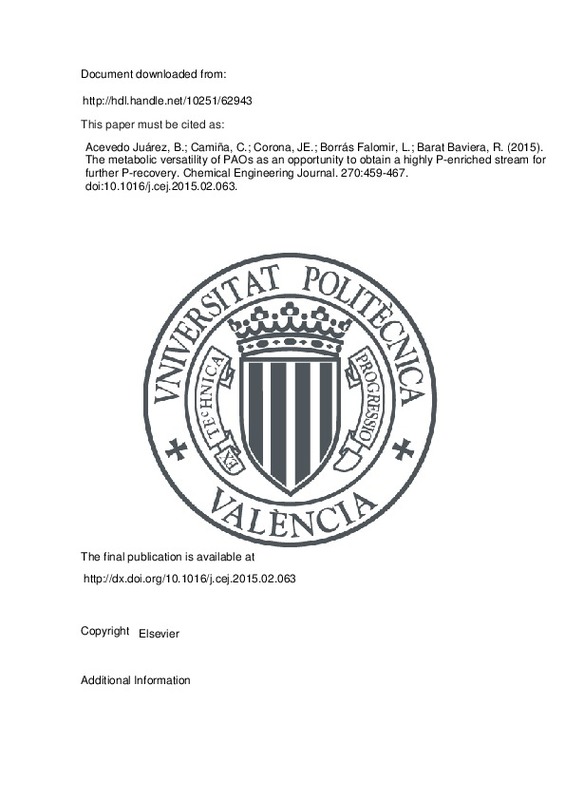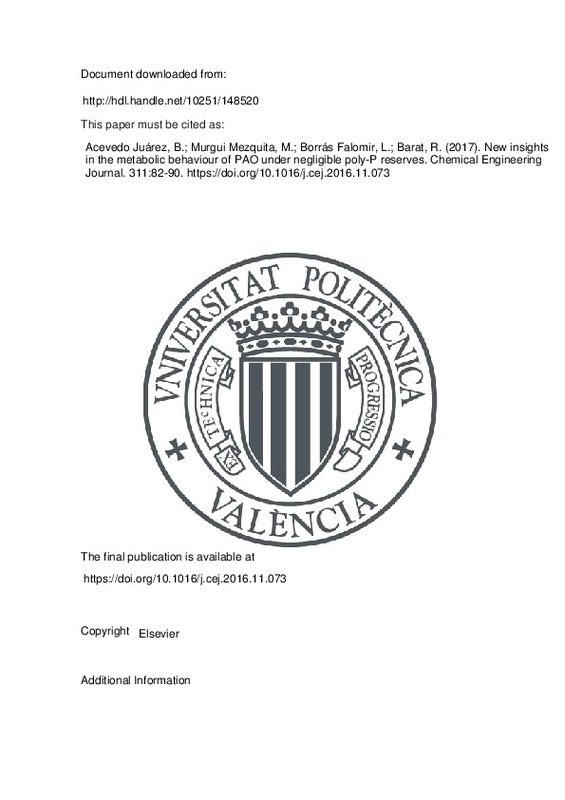Acevedo, B.; Oehmen, A.; Carvalho, G.; Seco, A.; Borras, L.; Barat Baviera, R. (2012). Metabolic shift of polyphosphate-accumulating organisms with different levels of polyphosphate storage. Water Research. 46(6):1889-1900. doi:10.1016/j.watres.2012.01.003
Por favor, use este identificador para citar o enlazar este ítem: http://hdl.handle.net/10251/47497
|
Título:
|
Metabolic shift of polyphosphate-accumulating organisms with different levels of polyphosphate storage
|
|
Autor:
|
Acevedo, B.
Oehmen, A.
Carvalho, G.
Seco, A.
Borras, L.

 Barat Baviera, Ramón
Barat Baviera, Ramón
|
|
Entidad UPV:
|
Universitat Politècnica de València. Departamento de Ingeniería Hidráulica y Medio Ambiente - Departament d'Enginyeria Hidràulica i Medi Ambient
|
|
Fecha difusión:
|
|
|
Resumen:
|
Previous studies have shown that polyphosphate-accumulating organisms (PAOs) are able to behave as glycogen-accumulating organisms (GAOs) under different conditions. In this study we investigated the behavior of a culture ...[+]
Previous studies have shown that polyphosphate-accumulating organisms (PAOs) are able to behave as glycogen-accumulating organisms (GAOs) under different conditions. In this study we investigated the behavior of a culture enriched with Accumulibacter at different levels of polyphosphate (poly-P) storage. The results of stoichiometric ratios Gly degraded/HAc uptake, PHB synthesized/HAc uptake, PHV synthesized/HAc uptake and P release/HAc uptake confirmed a metabolic shift from PAO metabolism to GAO metabolism: PAOs with high poly-P content used the poly-P to obtain adenosine tri-phosphate (ATP), and glycogen (Gly) to obtain nicotinamide adenine dinucleotide (NADH) and some ATP. In a test where poly-P depletion was imposed on the culture, all the acetate (HAc) added in each cycle was transformed into polyhydroxyalkanoate (PHA) despite the decrease of poly-P inside the cells. This led to an increase of the Gly degraded/HAc uptake ratio that resulted from a shift towards the glycolytic pathway in order to compensate for the lack of ATP formed from poly-P hydrolysis. The shift from PAO to GAO metabolism was also reflected in the change in the PHA composition as the poly-P availability decreased, suggesting that polyhydroxyvalerate (PHV) is obtained due to the consumption of excess reducing equivalents to balance the internal NADH, similarly to GAO metabolism. Fluorescence in situ hybridization analysis showed a significant PAO population change from Type I to Type II Accumulibacter as the poly-P availability decreased in short term experiments. This work suggests that poly-P storage levels and GAO-like metabolism are important factors affecting the competition between different PAO Types in enhanced biological phosphorus removal systems. © 2012 Elsevier Ltd.
[-]
|
|
Palabras clave:
|
Accumulibacter Type I
,
Accumulibacter Type II
,
Glycogen-accumulating metabolism (GAM)
,
Glycogen-accumulating organisms (GAO)
,
Polyphosphate (poly-P)
,
Polyphosphate-accumulating metabolism (PAM)
,
Polyphosphate-accumulating organisms (PAO)
,
Wastewater
,
Accumulibacter
,
Glycogen-accumulating metabolisms
,
Glycogen-accumulating organisms
,
Polyphosphate-accumulating metabolisms
,
Polyphosphate-accumulating organisms
,
Polyphosphates
,
Amides
,
Associative storage
,
Cell culture
,
Fluorescence microscopy
,
Physiology
,
Metabolism
,
Acetic acid
,
Adenosine triphosphate
,
Glycogen
,
Nicotinamide adenine dinucleotide
,
Polyhydroxyalkanoic acid
,
Polyhydroxyvalerate
,
Polyphosphate
,
Unclassified drug
,
Bacterium
,
Bioaccumulation
,
Chemical composition
,
Hydrolysis
,
In situ measurement
,
Stoichiometry
,
Waste treatment
,
Accumulibacter type 1
,
Accumulibacter type 2
,
Article
,
Bacterial metabolism
,
Fluorescence in situ hybridization
,
Glycogen accumulating organism
,
Glycolysis
,
Nonhuman
,
Polyphosphate accumulating organism
,
Priority journal
,
Storage
,
Waste component removal
,
Anaerobiosis
,
Bacteria
,
Biodegradation, Environmental
,
Biomass
,
Bioreactors
,
Carbon
,
Hydrogen-Ion Concentration
,
Metabolic Networks and Pathways
,
Phosphorus
,
Sewage
,
Volatilization
|
|
Derechos de uso:
|
Cerrado |
|
Fuente:
|
Water Research. (issn:
0043-1354
)
|
|
DOI:
|
10.1016/j.watres.2012.01.003
|
|
Editorial:
|
Elsevier
|
|
Versión del editor:
|
http://dx.doi.org/10.1016/j.watres.2012.01.003
|
|
Código del Proyecto:
|
info:eu-repo/grantAgreement/GV//PRE/2008/044/
...[+]
info:eu-repo/grantAgreement/GV//PRE/2008/044/
info:eu-repo/grantAgreement/UPV//PAID-06-08-3227/
info:eu-repo/grantAgreement/CONACYT//207966/
info:eu-repo/grantAgreement/FCT//PEst-C/EQB/LA0006/2011/
info:eu-repo/grantAgreement/FCT//PEst-OE/EQB/LA0004/2011/
info:eu-repo/grantAgreement/FCT//SFRH/BPD/30800/
2006/
[-]
|
|
Agradecimientos:
|
This research work has been supported by the Generalitat Valenciana (GVPRE/2008/044) and the Polytechnic University of Valencia (PAID-06-08-3227), which are gratefully acknowledged. Special acknowledgements to Consejo ...[+]
This research work has been supported by the Generalitat Valenciana (GVPRE/2008/044) and the Polytechnic University of Valencia (PAID-06-08-3227), which are gratefully acknowledged. Special acknowledgements to Consejo Nacional de la Ciencia y la Tecnologia de Mexico (CONACYT) No. 207966 and the Fundacao para a Ciencia e Tecnologia for PEst-C/EQB/LA0006/2011, PEst-OE/EQB/LA0004/2011 and SFRH/BPD/30800/2006.
[-]
|
|
Tipo:
|
Artículo
|






![[Cerrado]](/themes/UPV/images/candado.png)




